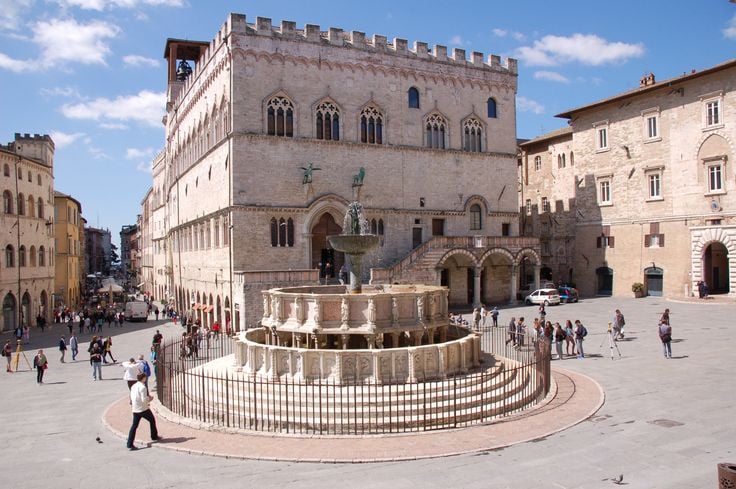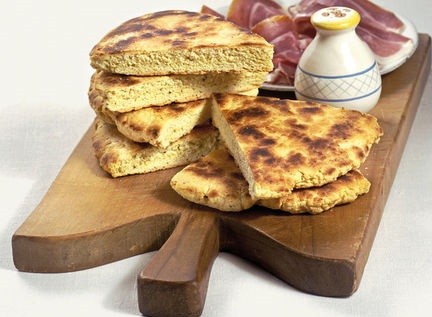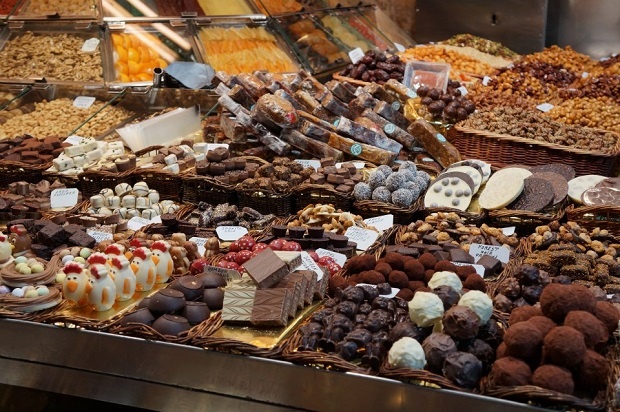Perugia is one of the most significant medieval cities in Italy. It has an extremely large historical centre with a vast artistic and cultural heritage ; it represents one of the most important tourist destinations in the Umbria region and not only. It is the seat of an ancient University and of a prestigious University for Foreigners. The city is located on a hill top of the Tiber river valley at about 450 metres above sea level. Perugia is also served by an airport and a railway line.
A historical centre not to be missed
The tour begins at the gateway to the city of Perugia, Rocca Paolina: a large fortress hiding a city within. Through paths and escalators you'll get to the heart of the city where local people love spending time together. One of the main monuments is undoubtedly the Fontana Maggiore, a thirteenth-century fountain consisting of two basins and located in Piazza IV Novembre. Here rises Palazzo Priori, the seat of the Council of Perugia and the National Gallery of Umbria. Inside the building there are the Collegio del Cambio and Collegio Mercanzia. Other important buildings are Palazzo Gallenza Stuart, today headquarters of the University for Foreigners; Palazzo del Capitano (or del Popolo); Palazzo della Penna built on the ruins of an ancient Roman amphitheatre which has now become a museum; Palazzo Cesaroni headquarters of the Regional Council of Umbria and many others. There is no lack of churches either: San Lorenzo Cathedral or Cathedral of Perugia is characterised by a typically Gothic aisle structure and houses works of great importance such as the 'Deposition' by Federico Barocci and 'Madonna delle Grazie' by G. Di Paolo. There, it is also preserved the Holy Ring, considered a masterpiece of Renaissance goldsmiths art. The Basilica of San Domenico is the largest church of Perugia and of the entire region. From the church there is a direct access to the bell tower which offers a panoramic view from Romagna to Abruzzo and from Le Marche to Tuscany. Don't miss a visit! Many sculptures are kept here, such as the tomb of Pope Benedict. The Basilica of San Pietro was built over the ancient cathedral present since the VII century. Inside you can admire works by Perugino and Vasari, as well as the paintings with scenes from the Life of Jesus, the Old and New Testament and the Triumph of the Benedictine Order. The entire Benedictine complex consists of three cloisters leading to the botanical gardens, the medieval vegetable garden, the Art Treasures Gallery, the library and the archive, which houses books, codes and ancient manuscripts. Guided tours can be organised.
The Church of Santa Giuliana, seat of the Italian Army Foreign Language School is characterised by an ancient cloister that is one of the finest examples of Cistercian architecture in Italy. The Church of San Filippo Neri, baroque style and the Church of San Michele Arcangelo, one of the first early Christian churches in Italy with circular plan, are worth a visit! There are many theatres; the main ones are Teatro del Pavone and Teatro Morlacchi. Perugia also has two walls; the Etruscan and the Medieval walls. The former include the Etruscan arch and Porta Marzia, while the medieval ones still preserve Porta di Sant'Angelo and Porta di San Pietro. Perugia is full of squares, rises and descents, alleys and stairways. Undoubtedly the most famous square is Piazza Italia with the renowned Corso Vannucci bursting with boutiques, restaurants and bars. Via Maestà delle Volte is instead the most charming street in town. Finally the Aqueduct, currently used as a pedestrian path, which offers a beautiful panoramic view of the city.

What’s with the cooking?
Like Umbrian cuisine, even local cooking traditions in Perugia focus on agriculture and meat products. For that, dishes are simple and often based on game. Among the first courses you can find 'cappelletti in brodo' (literally 'little hat', that is a kind of stuffed fresh pasta served in broth), potato gnocchi with duck sauce and tagliatelle with ragù. As main course people commonly have stuffed pigeon, roast pork and mixed grill. The 'erba campagnola' (field salad) is a wonderful side dish. It is a mix of wild herbs boiled and sautéed with olive oil and garlic. 'Cresce' and 'focacce' are also very popular in the Umbrian cuisine, first and foremost the Torta al testo, which is a savory pie that originally substituted bread. It is one of the most common dishes served in the many village food festivals. It can be stuffed with cold cuts, cheese and field salad. 'Torta al formaggio' (cheese cake) and 'bruschetta' with extra virgin olive oil are served mostly as a starter. There are many different varieties of local desserts, such as the Torcolo di San Costanzo, a donut shaped cake that was created in honour of San Costanzo, one of the three patron saints of Perugia. It is made of raisins, pine nuts, anise seeds and candied fruit. Another must-try is the Ciaramicola, a typical Easter sweet red in colour with white frosting and confetti on top. The Torciglione is a dry cake made with almonds with a spiral shape simililar to a coiled snake, while Le Pinoccate is a diamond shaped dessert with sugar and pine nuts, typical of Christmas time. During Carnival, frappe and strufoli are prepared. Wine has a strong tradition as well. Worthy of note Grechetto, Trebbiano, Sangiovese, Chardonnay, Merlot, Montefalco and many others. Many tours of vineyards and local wineries are organised throughout the year.

Events in Perugia
Perugia has a packed events calendar! Among the most important events, the renowned international exhibition Eurochocolate in October, which makes the city become a desirable destination for chocolate lovers with lots of food stands. Another important date is the music festival Umbria Jazz, one of the main jazz festivals in Europe. During the month of July for ten days, there are concerts of jazz and entertainment. In May the Perugia Flower Show takes place with a market exhibition of rare plants. On this occasion gardening courses and creative demonstrations for adults and children are organised. During the month of May there are also educational activities, games and educational workshops for children. During summer there is no shortage of exhibitions, theatre performances, conferences, dances, concerts, events for animal lovers and much more. Obviously, agri-food fairs are widely popular in the area: from the ham festival to that of the pigeon, along with village festivals and wine tastings.












